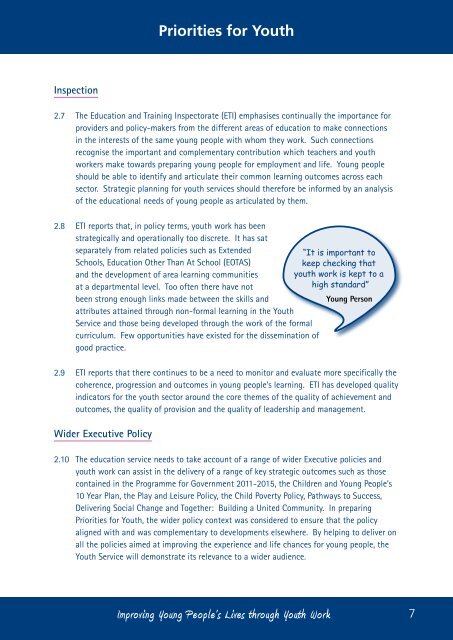Priorities for Youth
1G9j7BLbK
1G9j7BLbK
- No tags were found...
Create successful ePaper yourself
Turn your PDF publications into a flip-book with our unique Google optimized e-Paper software.
<strong>Priorities</strong> <strong>for</strong> <strong>Youth</strong><br />
Inspection<br />
2.7 The Education and Training Inspectorate (ETI) emphasises continually the importance <strong>for</strong><br />
providers and policy-makers from the different areas of education to make connections<br />
in the interests of the same young people with whom they work. Such connections<br />
recognise the important and complementary contribution which teachers and youth<br />
workers make towards preparing young people <strong>for</strong> employment and life. Young people<br />
should be able to identify and articulate their common learning outcomes across each<br />
sector. Strategic planning <strong>for</strong> youth services should there<strong>for</strong>e be in<strong>for</strong>med by an analysis<br />
of the educational needs of young people as articulated by them.<br />
2.8 ETI reports that, in policy terms, youth work has been<br />
strategically and operationally too discrete. It has sat<br />
separately from related policies such as Extended<br />
“It is important to<br />
Schools, Education Other Than At School (EOTAS)<br />
keep checking that<br />
and the development of area learning communities youth work is kept to a<br />
at a departmental level. Too often there have not<br />
high standard”<br />
been strong enough links made between the skills and<br />
Young Person<br />
attributes attained through non-<strong>for</strong>mal learning in the <strong>Youth</strong><br />
Service and those being developed through the work of the <strong>for</strong>mal<br />
curriculum. Few opportunities have existed <strong>for</strong> the dissemination of<br />
good practice.<br />
2.9 ETI reports that there continues to be a need to monitor and evaluate more specifically the<br />
coherence, progression and outcomes in young people’s learning. ETI has developed quality<br />
indicators <strong>for</strong> the youth sector around the core themes of the quality of achievement and<br />
outcomes, the quality of provision and the quality of leadership and management.<br />
Wider Executive Policy<br />
2.10 The education service needs to take account of a range of wider Executive policies and<br />
youth work can assist in the delivery of a range of key strategic outcomes such as those<br />
contained in the Programme <strong>for</strong> Government 2011-2015, the Children and Young People’s<br />
10 Year Plan, the Play and Leisure Policy, the Child Poverty Policy, Pathways to Success,<br />
Delivering Social Change and Together: Building a United Community. In preparing<br />
<strong>Priorities</strong> <strong>for</strong> <strong>Youth</strong>, the wider policy context was considered to ensure that the policy<br />
aligned with and was complementary to developments elsewhere. By helping to deliver on<br />
all the policies aimed at improving the experience and life chances <strong>for</strong> young people, the<br />
<strong>Youth</strong> Service will demonstrate its relevance to a wider audience.<br />
Improving Young People’s Lives through <strong>Youth</strong> Work<br />
7


